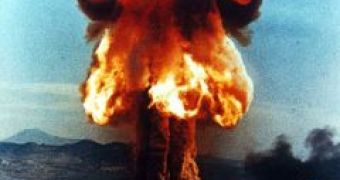An international team found, based on computer simulations, that even a small-scale, regional nuclear war could produce as many direct fatalities as the entire World War II and disrupt the climate for a decade or more with devastating effects over the whole Earth.
Against the backdrop of growing tensions in the Middle East and nuclear menace elsewhere in Asia, the authors warn that even the smallest nuclear powers may have as many as 50 or more Hiroshima-size (15 kiloton) weapons in their arsenals; about 40 countries have enough plutonium and/or uranium to construct substantial nuclear arsenals.
The study focused on scenarios of smoke emissions that urban firestorms could produce and analyzed potential fatalities based on an assessment of current nuclear weapons inventories and population densities in large urban complexes. "The results represent the first comprehensive quantitative study of the consequences of a nuclear conflict between smaller nuclear states," said Owen Toon, chair of the department of atmospheric and oceanic sciences and a member of the Laboratory for Atmospheric and Space Physics at CU-Boulder. "A small country is likely to direct its weapons against population centers to maximize damage and achieve the greatest advantage," Toon said.
Estimated fatality varied from 2.6 million to 16.7 million per country. The team made a series of computer simulations depicting potential climatic anomalies that a small-scale nuclear war could bring about, guided by climate modeling tools previously employed in assessing volcano-induced climate change. "Considering the relatively small number and size of the weapons, the effects are surprisingly large. The potential devastation would be catastrophic and long term," said Richard Turco, professor of atmospheric and oceanic sciences, and a member and founding director of UCLA's Institute of the Environment.
While a regional nuclear confrontation among emerging third-world nuclear powers might be geographically constrained, the climate impacts could be worldwide. "We examined the climatic effects of the smoke produced in a regional conflict in the subtropics between two opposing nations, each using 50 Hiroshima-size nuclear weapons to attack the other's most populated urban areas," said Alan Robock, a professor in the department of environmental sciences and associate director of the Center for Environmental Prediction at Rutgers' Cook College.
Simulations using a modern climate model coupled with estimates of smoke emissions amounted to as much as 5 million metric tons of "soot" particles. "A cooling of several degrees would occur over large areas of North America and Eurasia, including most of the grain-growing regions," Robock said. "As in the case with earlier nuclear winter calculations, large climatic effects would occur in regions far removed from the target areas or the countries involved in the conflict."
The 1815 eruption of Tambora in Indonesia, the largest volcanic eruption in the last 500 years, was followed by killing frosts throughout New England in 1816, known as "the year without a summer." The European weather was so cold and wet that the harvest failed and people starved.
But climate disruptions following a regional nuclear conflict greatly surpass large volcanic eruptions. The Tambora climatic disruption lasted for only about one year. In computer simulation, in which carbon particles stay in the stratosphere for up to 10 years, the climatic effects are greater and last longer than those associated with the Tambora eruption. "With the exchange of 100 15-kiloton weapons as posed in this scenario, the estimated quantities of smoke generated could lead to global climate anomalies exceeding any changes experienced in recorded history," Robock said. "And that's just 0.03 % of the total explosive power of the current world nuclear arsenal."

 14 DAY TRIAL //
14 DAY TRIAL //